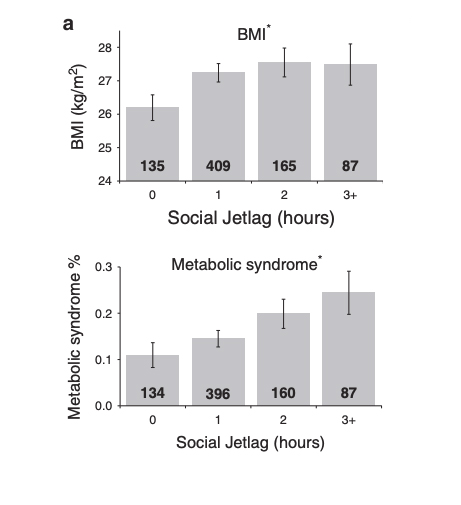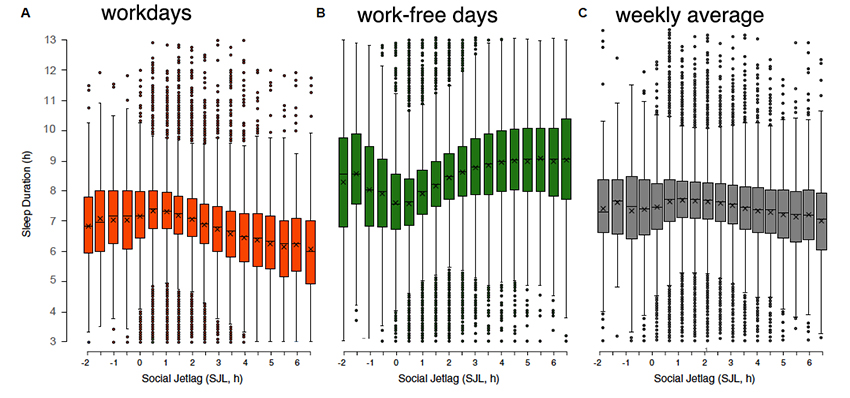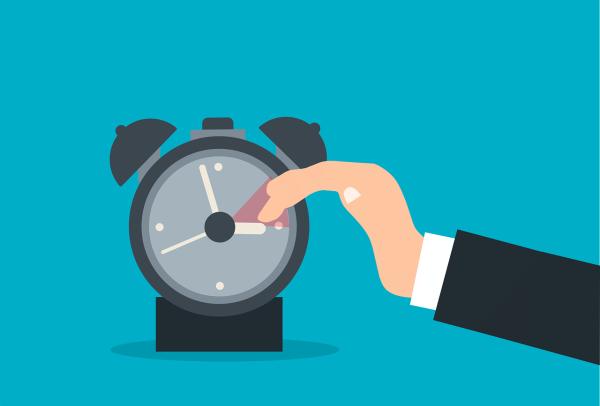From an evolutionary point of view, we live on a planet with an established pattern of light and dark, so it is not a giant leap to consider that synchronizing our body’s physiology to match that pattern has some advantages. To understand these circadian rhythms, we begin with the master clock, a set of genes located in a part of the brain called the suprachiasmatic nucleus (SCN) that receives input, especially from our eyes.
During the day, two genes (Clock and BMal1) activate a second pair of genes that create two proteins, PER and CRY. Those proteins, in turn, move into the nucleus, where they turn off Clock and BMal1. At night, PER and CRY are degraded, releasing the inhibition and beginning the cycle again. [1] In addition to numerous neural connections, the SCN releases hormones providing signals to the entire body, including several additional clocks in peripheral tissue.
Nature resets our circadian rhythm every day through the connection between the SCN and our eyes. Sunrise and sunset feature orange and red light (600-700nm) caused by atmospheric scattering. In the hours after sunrise and before sunset, the sun’s light puts out a great deal of light in the blue end of the spectrum (400-500nm). At night, before Edison, there was only moonlight, which is predominantly in the blue end of the spectrum.
Circadian rhythms are regulated by the light in the 460-500nm range, which interacts with special, non-visual retinal cells [2] that send signals to the SCN and reset the Clock gene. That blue spectrum stimulation causes the release of hormones helpful to “navigate the day,” hormones involved with stress, impulse control, alertness, hunger, metabolism, and reproduction. The absence of that blue spectrum stimulation increases the hormones helpful to “navigate the night,” reducing metabolism, carrying out repair and maintenance, and promoting sleep. Pretty Neat!
Now you can understand why “Light at Night,” especially the blue light of screens, is disruptive of sleep; you’re telling your circadian rhythm that it is daytime. But this is not the only possible disruption.
- Sleep – Circadian rhythms determine the onset and phases of sleep. In adolescence, onset is delayed; teenagers stay up late. In the elderly, the initial phase of sleep is disrupted, making it harder to “go to sleep.” The deepest, reparative sleep is also reduced, impeding bodily repair.
- Immune Response – Our T cells are most active at night, partially “in response to nocturnal production of melatonin;” our B cells (those making antibodies) are more active in the day, responding to “morning neurotransmitters.” An imbalance of the two can alter our immune response to make us more susceptible to infection.
- Metabolism – Leptin, a key hormone in our energy metabolism, peaks at night. Disruption of circadian rhythm alters leptin level impacted a range of our metabolic energy responses. Insulin sensitivity and release diminishes at night; losing sleep may result in “morning hyperglycemia (high blood sugar) independent of eating patterns.” The diurnal variation in hormones affecting sympathetic nervous activity is felt to be responsible for the increased incidence of both myocardial infarctions and asthma attacks at night.
Metabolism also impacts our circadian rhythms. The signals, zeitgebers [3], include when and what we eat and when and how we exercise
The Impact of Time
The impacts of “springing ahead or falling behind” reflect our increased wakefulness or sleepiness as we change forward or back. The American Academy of Sleep Medicine and physicians interested in sleep have long championed ending the back and forth. They are not as happy with the Senate Resolution, which made Daylight Saving Time (DST) the new standard; they prefer, for health reasons, that we adopt a Permanent Standard Time.
"Permanent standard time is better aligned to human circadian biology … Daylight saving time increases morning exposure to darkness and evening exposure to sunlight, therefore disrupting the timing of our bodies' circadian rhythm, causing negative impacts on health and safety."
Shalini Paruthi, MD spokesperson AASM
Despite the press coverage, the negative impacts on our health last about one week. They are more semi-annual talking points than real concerns. Can science offer us any help in forming an opinion? Consider a review in Frontiers in Physiology. They begin by defining three types of inter-related clocks.
- Solar – noon is when the sun is directly overhead
- Circadian – our body clock, created by evolution and reset daily. For most of us, not doing shift work, solar and circadian times are close enough to be considered the same.
- Social – another “social construct” is the time in our time zone, the one we use in our business and social institutions. Social and solar time align if you are right on the time zone meridian. As you move west in your time zone, social and solar time separate until they are one hour apart, and you reach the next time meridian.
“The association between health and the body clock depends on the degree of misalignment between body clock and social clock.”
The zeitgeber of sunlight took a significant hit in 1880 when Edison’s incandescent light bulb was used in a bank in New York. Safe light at night greatly expanded our social clocks, leaving our circadian clock frequently in permanent misalignment. The natural differences between night owls and morning larks can be up to five hours; thanks to Edison, that difference can now be 12 hours.
When speaking about our social clocks
- 36% of us are set in our time zone
- about 24% live more than 30 minutes to the East (East is earlier, West is later)
- 18% have social clocks 30 minutes or more to the West
- The remaining 32% have social clocks that can be hours to the West.
- But we all must get up for work at the same solar time!
DST adds another hour to our social clock, furthering that misalignment. The misalignment of our social and biological clocks is termed social jetlag (SJL). It is best typified by teenagers and the perennial discussion of why school should begin much later than 7 or 8 AM. That social time is one or two hours ahead of their biological time.
DST moves your time east; late-night screen time moves time west. Both create social jetlag.
Some studies suggest that as the SJL increases, there are changes to our health. One study using the SEER dataset showed a small but increased incidence of cancer (about 2-3%) as you moved to the West within a time zone.
 In one study of 800 non-shift workers, SJL correlated with increasing obesity, measured by BMI, and metabolic dysfunction, as measured by metabolic syndrome.
In one study of 800 non-shift workers, SJL correlated with increasing obesity, measured by BMI, and metabolic dysfunction, as measured by metabolic syndrome.
Social jetlag can profoundly affect sleep. In a study involving over 300,000 individuals who completed the MCTQ survey [4], increasing social jetlag decreased sleep on workdays, with increased sleep, but incomplete recovery on weekends.

“In summary, the scientific literature strongly argues against the switching between DST and Standard Time and even more so against adopting DST permanently.”
Either adoption of DST or Standard Time will result in winners and losers. You can see where you fall with this interactive graphic, which I urge you to try. The researchers offer an interesting compromise, given that DST is a social construct. Why not have work and school be more flexible, accommodating “personal biological and social requirements.”
A George Santayana moment
In December 1973, Congress, backed by 79% of the population, placed us on DST for two years. Within three months, that number had dropped to 42%. By October 1974, Congress restored the oscillation between DST and Standard Time. As a House committee noted, “Energy savings must be balanced against a majority of the public’s distaste for the observance of Daylight Saving Time.” And by the way, we have never demonstrated any energy savings.
[1] For those looking for a fancy phrase to throw into a conversation, this process is a “transcription-translation feedback loop.”
[2] These are the intrinsic photosensitive Retinal Ganglion Cells
[3] Readers, please forgive me; zeitgeber is German for “time-givers” and is a term used in chronobiology. It was such a nice word, and I couldn't resist finding somewhere to put it in this article.
[4] The Munich ChronoType Questionaire is considered a standard measurement instrument in chronobiology. The survey results are aggregated, increasing the size of the database over time. It asks self-reported questions about sleep and is based on the assumption that sleep on work-free days is the best measure of our circadian clocks.
Additional Sources: Circadian Rhythm and Human Health
Systematic review of light exposure impact on human circadian rhythm Chronobiology International DOI: 10.1080/07420528.2018.1527773
Effect of Circadian Rhythm on Metabolic Processes and the Regulation of Energy Balance Annals of Nutrition and Metabolism DOI:10.1159/000500071
Circadian Rhythm Abnormalities Continuum DOI: 10.1212/01.CON.0000427209.21177.aa




